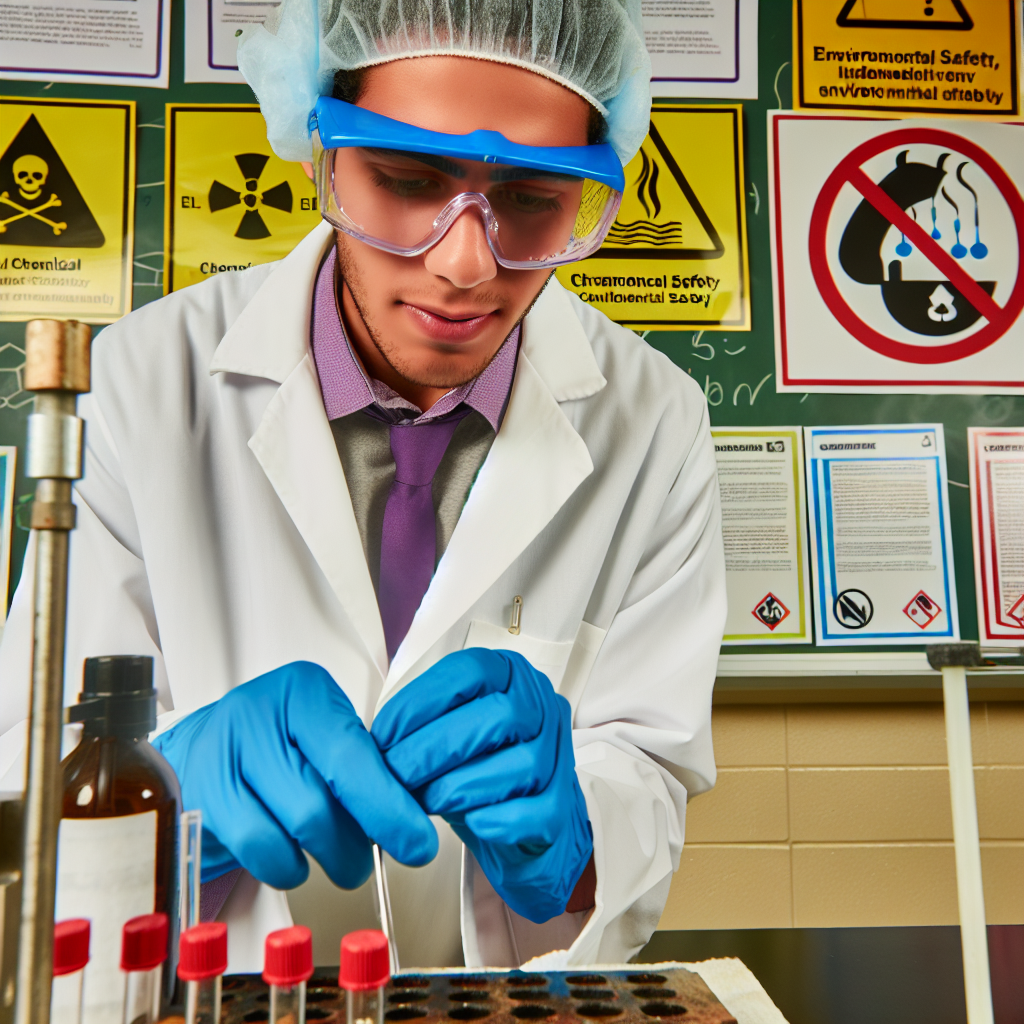Introduction to Chemical Engineering and Environmental Safety
Chemical engineering plays a crucial role in various industries.
It involves the application of chemistry, physics, and mathematics.
The primary goal is to transform raw materials into useful products.
However, this process can impact the environment significantly.
Understanding Environmental Safety
Environmental safety focuses on preventing harm to ecosystems.
Chemical engineers must consider the environmental impact of their processes.
They work to ensure compliance with environmental regulations.
Additionally, they develop methods to minimize waste and emissions.
Key Responsibilities of Chemical Engineers
Chemical engineers assess the safety of chemical processes.
They evaluate potential hazards associated with various substances.
Another task is designing safer chemical production systems.
Furthermore, they conduct risk assessments to identify issues.
Innovative Solutions for Environmental Challenges
Chemical engineers are at the forefront of innovative solutions.
They develop sustainable materials that reduce environmental impact.
Additionally, they focus on green chemistry principles.
These principles promote the design of processes that minimize the use of hazardous substances.
Collaboration Across Disciplines
Effective environmental safety requires collaboration.
Chemical engineers often work with environmental scientists and policymakers.
This interdisciplinary approach leads to comprehensive safety solutions.
Moreover, collaboration strengthens public awareness regarding environmental issues.
The Importance of Environmental Safety in Chemical Engineering
Understanding Environmental Safety
Environmental safety involves protecting the ecosystem from harmful impacts.
It ensures a sustainable balance between industry practices and nature.
In chemical engineering, this concept is crucial for public health and the environment.
The Impact of Chemical Processes
Chemical processes can generate emissions and waste that harm the environment.
These impacts can lead to air and water pollution.
Unlock Your Career Potential
Visualize a clear path to success with our tailored Career Consulting service. Personalized insights in just 1-3 days.
Get StartedThus, engineers must create systems that minimize hazardous outputs.
Regulatory Compliance and Best Practices
Compliance with environmental regulations is a primary responsibility for chemical engineers.
They must stay informed about laws like the Clean Air Act and Clean Water Act.
Implementing best practices ensures safe operation and reduces legal risks.
- Regular audits of processes and waste management systems
- Continuous training for employees on safety and regulations
- Use of environmentally friendly materials whenever possible
Innovations in Green Chemistry
Green chemistry offers innovative solutions for minimizing environmental impacts.
This approach emphasizes sustainability in chemical production and utilization.
Engineers can design processes that reduce waste and energy consumption.
Examples include using renewable resources and developing biodegradable materials.
Community Engagement and Awareness
Engaging with local communities is essential for promoting environmental safety.
Chemical engineers can conduct workshops to promote awareness about safety measures.
Collaboration with community stakeholders leads to better environmental outcomes.
Key Roles of Chemical Engineers in Pollution Prevention
Designing Sustainable Processes
Chemical engineers design processes that minimize waste generation.
They focus on reducing emissions throughout production stages.
Additionally, they implement innovative technologies.
These technologies often utilize renewable resources effectively.
Conducting Environmental Assessments
Environmental assessments are vital to evaluating potential impacts.
Chemical engineers conduct thorough evaluations before project implementation.
They analyze data to identify pollution sources.
Furthermore, they propose strategies to mitigate these risks.
Enhancing Resource Efficiency
Resource efficiency is a primary goal in chemical engineering.
Engineers strive to use materials in the most effective manner.
This practice helps conserve energy and raw materials.
Moreover, engineers develop methods to recycle waste products.
Implementing Regulatory Compliance
Chemical engineers ensure compliance with environmental regulations.
They keep updated with local and international laws.
By doing so, they cultivate safer production atmospheres.
This commitment ultimately protects public health and ecosystems.
Education and Training
Education is crucial for preparing future engineers in sustainability.
Chemical engineers often lead workshops and seminars.
They share best practices for pollution prevention techniques.
Furthermore, they mentor students and young professionals.
Collaboration with Other Disciplines
Collaboration fosters innovative pollution prevention strategies.
Chemical engineers often partner with environmental scientists.
They also work with regulatory bodies and industries.
These collaborations enhance the effectiveness of solutions.
Uncover the Details: Mechatronics vs Mechanical Engineering in Canada
Innovative Technologies Developed by Chemical Engineers for Environmental Protection
Advanced Wastewater Treatment
Chemical engineers design cutting-edge processes for wastewater treatment.
These processes reduce harmful contaminants effectively.
Innovations include membrane bioreactors and advanced oxidation techniques.
These technologies yield cleaner water, benefiting ecosystems and communities.
Renewable Energy Solutions
Chemical engineers create sustainable energy solutions to combat climate change.
They develop technologies for biofuels from organic waste materials.
Moreover, engineers work on improving solar energy conversion techniques.
These solutions help reduce dependency on fossil fuels significantly.
Air Pollution Control Technologies
Engineers design systems to capture and reduce air pollutants.
Technologies include catalytic converters and advanced filtration systems.
These innovations improve air quality and protect public health.
Furthermore, engineers continuously refine their methods for better efficiency.
Green Chemical Processes
Chemical engineers focus on creating greener chemical processes.
These processes reduce waste and use fewer hazardous materials.
Examples include safer solvents and more efficient reaction pathways.
Such advancements contribute significantly to a sustainable future.
Resource Recovery and Recycling
Innovative recycling technologies developed by chemical engineers enhance resource recovery.
These systems recover valuable materials from waste streams.
Engineers improve recycling efficiency through advanced separation techniques.
Consequently, this minimizes waste sent to landfills.
Find Out More: Certifications That Boost Aerospace Engineering Careers
Regulatory Compliance: Chemical Engineers’ Responsibilities in Meeting Environmental Standards
Understanding Regulatory Frameworks
Chemical engineers play a critical role in understanding regulatory frameworks.
They must stay updated on local, national, and international environmental regulations.
This knowledge helps ensure compliance in their projects.
Additionally, they interpret complex legal documents and guidelines.
Developing Compliance Strategies
Creating effective compliance strategies is essential for chemical engineers.
They assess potential environmental impacts of engineering processes.
Subsequently, they develop plans to mitigate identified risks.
These plans often include adopting best practices for waste management.
Furthermore, engineers may implement cleaner production techniques.
Conducting Environmental Assessments
Chemical engineers conduct thorough environmental assessments.
These assessments identify potential environmental hazards too.
They evaluate risk factors related to chemical processes and materials.
This evaluation forms the basis for regulatory reporting.
In addition, engineers may recommend improvements based on their findings.
Ensuring Compliance Through Monitoring
Monitoring is vital in maintaining regulatory compliance.
Chemical engineers design and implement monitoring systems for pollutants.
These systems track emissions and waste disposal practices.
Regular audits and inspections ensure ongoing compliance.
Engineers analyze monitoring data to identify trends and issues.
Training and Education
Training employees is another vital responsibility for chemical engineers.
They develop educational programs focused on environmental safety.
These programs emphasize the importance of compliance and best practices.
Furthermore, engineers regularly update training materials to reflect new regulations.
Collaboration with Regulatory Agencies
Chemical engineers often collaborate with regulatory agencies.
This collaboration aids in developing realistic compliance strategies.
Engineers provide insight based on technical expertise and practical experience.
Moreover, they participate in discussions about regulatory updates.
Engaging with these agencies fosters a culture of compliance.
See Related Content: How to Build a Portfolio for Aerospace Engineering

Risk Assessment and Management Practices in Chemical Engineering
Importance of Risk Assessment
Risk assessment identifies potential hazards in chemical processes.
It evaluates the likelihood of incidents occurring.
Furthermore, it estimates the consequences of those incidents.
This process protects both workers and the environment.
Key Components of Risk Assessment
First, hazard identification evaluates materials and processes.
Next, risk analysis assesses the severity and frequency of events.
Consequence analysis helps understand the potential impact.
Finally, risk evaluation compares risks against acceptable levels.
Risk Management Strategies
Effective risk management reduces potential hazards.
First, companies implement engineering controls to mitigate risks.
Next, operational procedures reinforce safety protocols.
Regular training ensures workers are aware of risks.
Additionally, emergency response plans prepare for incidents.
Regulatory Framework
Regulatory agencies set standards for safety in chemical engineering.
Agencies like the Environmental Protection Agency enforce regulations.
Compliance ensures companies meet safety and environmental requirements.
Subsequently, it fosters a culture of safety within organizations.
Continuous Improvement
Risk management practices require ongoing assessment.
Regular audits identify areas for improvement.
Feedback from incidents leads to better protocols.
This cycle promotes a safer working environment.
Discover More: Aerospace Engineering for Defense and Security
Case Studies: Successful Environmental Initiatives Led by Chemical Engineers
Innovative Wastewater Treatment Solutions
One prominent initiative involved a project in Riverview aimed at reducing wastewater pollutants.
Chemical engineers developed an advanced oxidation process to treat industrial wastewater.
This technique significantly lowered the levels of harmful chemicals released into local waterways.
As a result, the water quality in Riverview improved, benefiting aquatic life.
Green Chemical Manufacturing
Another successful case occurred at BioGreen Chemicals in San Diego.
Chemical engineers implemented a sustainable approach to chemical production.
They optimized processes that reduced energy consumption and waste generation.
This initiative not only enhanced efficiency but also minimized the company’s carbon footprint.
Bioremediation of Contaminated Sites
The cleanup of a contaminated site in Springfield demonstrated the power of bioremediation.
Chemical engineers employed microorganisms to break down hazardous substances in the soil.
This bioremediation effort restored the site effectively and efficiently.
Consequently, the land was returned to community use without harmful residues.
Development of Eco-Friendly Products
At EcoSafe Materials, engineers focused on creating biodegradable plastics.
They utilized renewable resources to develop these eco-friendly alternatives.
This development reduced reliance on petroleum-based plastics significantly.
As a result, EcoSafe’s products helped decrease plastic pollution in the environment.
Sustainable Energy Initiatives
An ambitious project in Green Valley aimed to develop sustainable energy solutions.
Chemical engineers designed a facility to produce biofuels from agricultural waste.
This initiative turned waste into a valuable resource, supporting local farmers.
Moreover, it contributed to energy independence and reduced greenhouse gas emissions.
Future Trends in Chemical Engineering and Their Impact on Environmental Safety
Emerging Technologies in Chemical Engineering
Advanced technologies are reshaping the field of chemical engineering.
Innovations such as nanotechnology enhance material effectiveness.
Furthermore, bioprocessing is gaining momentum in producing sustainable chemicals.
These technologies offer promising solutions for reducing environmental footprints.
Impact of Regulatory Changes
New regulations are influencing the practices of chemical engineers.
Stricter environmental standards drive companies to adopt cleaner processes.
Consequently, engineers must continually adapt to remain compliant.
This enhances environmental safety by minimizing harmful emissions.
Integration of Artificial Intelligence
Artificial Intelligence (AI) is transforming chemical engineering processes.
AI can optimize production routes to reduce waste generation.
Additionally, predictive maintenance prevents accidents and environmental hazards.
As a result, AI contributes to safer and more efficient operations.
Focus on Green Chemistry
Green chemistry principles are becoming essential in chemical engineering.
This approach prioritizes design and synthesis to minimize toxicity.
Moreover, it encourages the use of renewable resources over finite materials.
Thus, green chemistry fosters sustainability and environmental protection.
Collaboration with Environmental Scientists
Interdisciplinary collaboration is increasingly important in chemical engineering.
Partnerships with environmental scientists lead to innovative solutions.
These collaborations focus on addressing complex environmental challenges.
Consequently, engineers can develop safer materials and processes.
Education and Continuous Learning
The evolving landscape requires ongoing education for chemical engineers.
Professionals must stay informed about new technologies and best practices.
Continuous learning enables engineers to implement effective safety measures.
Ultimately, this knowledge promotes a culture of safety within organizations.
Additional Resources
ChemE in Environment, Sustainability and Energy | UW Chemical …




